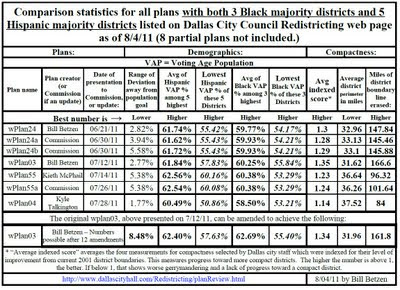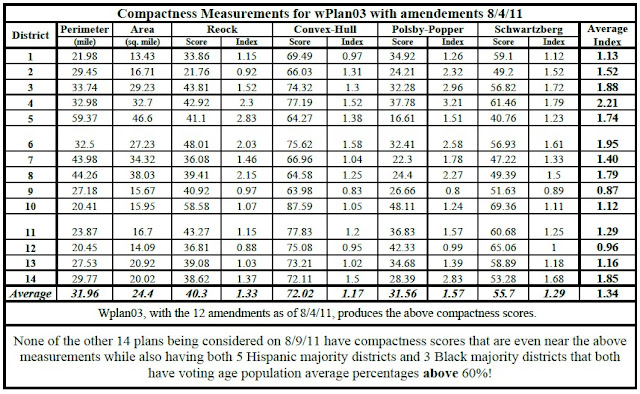The pages below compare Map 16 districts with Map 3 districts. They show, district by district, how potential minority representation was gerrymandered and damaged in Map 16, and how it was enhanced in Map 3 with the more compact maps. If you want to present your council representative or the Mayor with evidence as to why you prefer Map 3 over 16, click on the map below that represents your neighborhood, print it, and send it to them asking that they use Map 3 as the new redistricting map for Dallas for the next decade.
============================================================
District 6
Which District 6 map below will provide the best representation for families living near Love Field? (Click to enlarge.)============================================================
District 3
In Map 16, District 3 is 53.94% Hispanic voting age population (VAP). In Map 3 the Hispanic VAP for District 3 is 62.05%. Which of the maps below will provide the best and most secure representation for West Dallas families? Or for the families in far Southwest Dallas? (Click to enlarge.)
In Map 16 the weakest of the three Black majority districts is District 7 (see below) with a Black voting age population (VAP) that is vulnerable at only 50.4%. With the movement of the current District 5 to the west to create a Black majority district in southwest Dallas, District 5 becomes the new "weakest" Black majority district, but significantly stronger, with a Black VAP that is 55.42% and 5 percentage points higher than the Map 16 District 7.
================================================================
These maps can be clicked on, once to select & once to enlarge, and then can be printed in either portrait (i.e. District 2) or landscape (i.e. District 6 or District 3) format, whichever is best, to show the comparison between the maps.
============================================================
District 2
District 2 only maintains the eastern end of the current District 2 in Map 3. Map 3 also strengthens the Hispanic vote by over 4 percentage points by unifying with far East Dallas north of Bruton Road. Gerrymandering is less of a factor in Map 3.
===========================================================
The South Side of Dallas
The above maps reflect differences between boundary lines for Map 3 and Map 16.
- In Map 16 District 5 has a voting age population (VAP) that is 64.10% Hispanic. In Map 3 District 5 represents the southwest corner of Dallas and has a VAP that is 55.42% Black.
- In Map 16 District 7 has a VAP that is 50.4% Black. In Map 3 District 7 is significantly less gerrymandered and has a VAP that is 66.36% Black.
- In Map 16 District 8 continues to the the longest district in Dallas but has a Black VAP that drops to 61.61%. In Map 3 District 8 is more compact with a Black VAP that is 67.42%.
- In Map 16 District 4 covers most of the area that District 7 does in Map 3. In Map 3 District 4 covers the southeast corner of Dallas, and most of the area known as Pleasant Grove, with a Hispanic VAP that is 61.98%.
- In Map 16 District 3 continues to cover far north Oak Cliff and far South Oak Cliff but only has a Hispanic VAP that is 53.94%. In Map 3 a more compact District 3 covers all of West Dallas and northwest Oak Cliff. It has a Hispanic VAP of 62.56%.
- In Map 16 District 1 was closest of any district to charges of packing with a Hispanic VAP of 70.56%. In Map 3 this was avoided by including much of downtown Dallas, and the former area of Little Mexico to embrace Dallas History. The Hispanic VAP for District 1 in Map 3 is 62.32%.
The bottom line for minority VAP: it is 1.8% higher on average for each of the 8 minority majority districts in Map 3 when compared with these same 8 districts in Map 16.
===========================================================
Below are numbers that reflect how the more gerrymandered lines of Map 16 damage minority representation in Dallas. Such gerrymandering should not be allowed to continue in a city that is now over 70% minority but still has a City Council that continues to be majority Anglo.
===========================================================
Print out the above maps for your neighborhood. Share them with neighbors if you see issues you want to address with the City Council. Here are email contacts for the Mayor and City Coucil.
If you want to study the full Map 16 that will be submitted to the Mayor, and Map 3 that was the first choice of one commissioner and the second choice of 12 of the remaining 14 commissioners, you may simply load each map in a different tab in your browser and click between them to compare the differences. Do a right click here for Plan 3 and then click "open in new tab." Do a right click here for Plan 16 and again click "open in new tab." These are large maps and may take a while to each load. Once both maps are loaded in different tabs, click on the tab for one of the maps. Then click on the tab for the other one. Now click back and forth between the tabs to compare maps. Move each map to the location you want to compare.
It has often been asked how the district maps produced by Map 3 (wPlan03c) have been so consistently more compact while also producing higher minority percentages. While there are many hundreds of elements that have combined with ideas from dozens and dozens of people along the way, the most central and consistent guidance came from the following map created June 9th:
The blog posting that day explains the history and reasoning behind this map that has guided the creation of wPlan03c. If you compare the above map with wPlan03c it will be noted that boundary lines were moved so as to eliminate any danger of charges of "packing." Other boundaries were moved so as to maximize "communities of interest," a valuable term when used with good intentions, but that can also be use in a way to remind one of a previous time when "separate but equal" was also considered a valuable and respected phrase.




















